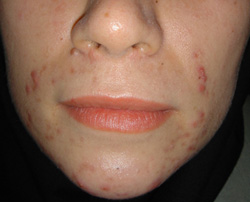IRANDERMA |
|
ACNE |
ACNE |
|
|
| SEBORRHEIC
DERMATITIS, DANDRUFF, OILY SKIN |
| PSORIASIS |
| ROSACEA |
| SUN SCREENS |
| SCABIES |
Acne is a common skin condition and virtually every adolescent will have a small number of acne spots at some stage, and others will have more. Although acne is most common in adolescents, and specifically is most frequent in the late teenage years, the condition may appear for the first time in the mid-twenties or even later; in fact, acne persists in a large number of people into their 40s or even their 50s!
Acne is a disease of the grease (sebaceous) glands and is characterized by blackheads, whiteheads, red spots, and sometimes deeper
boil-like lesions that dermatologists call nodules or cysts. 
There are several types of acne lesions, including blackheads and whiteheads (collectively termed comedones), larger pimples (papules) and eventually, pustules and large cysts. Scars occur after papules, pustules and cysts. They are often permanent.
The exact cause of acne is not known. It develops in the oil-producing structures of the skin called pilosebaceous follicles, which are present in large quantities on the face, chest, upper back and shoulders. One theory is that acne develops when hormone levels increase during puberty, causing the skin of the acne prone persons to react by producing excess sebum . The bacteria on the skin alters sebum to produce substances that cause acne. Dead skin cells, bacteria, hormones and altered sebum plug the hair follicle, the site where acne begins. This obstruction results in swelling and the development of lesions that dermatologists call "comedones," but that most people commonly refer to as simply whiteheads and blackheads. Emotional stress, fatigue and cosmetics can aggravate acne.
The importance of acne should not be underestimated because the disease can have important negative psychosocial consequences for the affected individual, including diminished self-esteem, social withdrawal due to embarrassment, depression, and unemployment. Provision of adequate therapy is therefore important, especially because satisfactory results from treatment can be achieved in most cases.
Psychological aspects of acne:
Some patients with acne will develop psychologic problems as a consequence of their condition. Even mild to moderate disease can be associated with significant depression and suicidal ideation and psychologic change does not necessarily correlate with disease severity. Acne scars themselves have been shown to produce significant psychopathology.Recent works confirmed that female acne patients can suffer from hypochondriasis, depression and schizoid problems, whereas in male patients with acne, paranoia and anxiety are more common.76% of acne patients considered that their skin changes were unattractive and this had an adverse effect on their sexual life.
When initiating treatment it is important to consider the aims of therapy. Treatment should be aimed at achieving clearance of acne, prevention of scarring and, where necessary, relief from any psychologic stress resulting from the acne. Therapy should be commenced early in the disease process in order to prevent scarring and it is important to select appropriate therapies according to the clinical signs and psychologic disability. Waiting to outgrow acne can be a serious mistake, since early treatment can immediately improve your appearance and prevent the formation of scars. It is also important to ensure that the patient is able to comply with therapy and clear guidelines regarding treatment, possible adverse effects and realistic expectations should be provided. To reduce the possibility of formation of scars, never pick, squeeze or scratch lesions. Although it is much easier said than done, a dermatologist will advise a person with acne to keep their hands off of their the face.
Three broad categories of therapy are useful in the treatment of acne:
Topical therapy is the mainstay for the management of all but the most severe forms of acne.
Comedolytic therapies (retinoids, including tretinoin, isotretinoin, adapalene and tazarotene; salicylic acid;and possibly, alfa-hydroxy acids) reduce the number of microcomedones, while antibacterial therapies ( benzoil peroxide and antibiotics such as erythromycin and clindamycin) reduce the intrafollicular population of P.acne. Miscellaneous compounds such as sulphur and resorcinol have also been used.A "comedolytic agent" helps acne breaking up comedones, or blackheads, and is often one of the first medicines that a dermatologist will prescribe for a person with acne. Azelaic acid is a recently introduced comedolytic agent that also has some antibiotic properties. Clinical studies have shown the following properties contribute to the efficacy of
azelaic acid in treating mild to moderate acne:* demonstrates antimicrobial activity against Propionibacterium acnes (P.
acnes) and Staphylococcus epidermidis (Staph. epidermidis) Systemic antibiotics are often prescribed quickly by dermatologists
for persons with acne that is causing scars or has the potential to
cause scars. Tetracycline, doxycycline , and minocycline are often
the antibiotics of choice because they are generally effective and have
few side-effects in most people.
The female hormone estrogen, at high levels, can help improve acne.
Many women notice a worsening of acne just before their periods, which
is due to changes in their hormone levels at this time. Pills that
contain estrogen can help acne, however, progesterone-only pills (such
as the so-called "mini pill") can make acne worse. Oral treatment with 13-cis-retinoic acid in severe acne is
normally successful, lasting for a number of years, and has improved the
quality of life for many adolescents. It reduces the sebum excretion
rate, restores desqumation and normalises the keratinisation process.
However, the side effects of 13cRA include epistaxis, pruritus and
effects on mucous membranes, leading to a lack of adherence by patients,
as well as teratogenicity. In fact, the first few weeks of treatment may
actually make the condition worse.
* normalizes the follicular hyperkeratosis associated with acne possesses
anti-inflammatory effects.
* The mechanism of action of
Azelaic acid, while not completely understood, leads to
the reduction of acne lesions
Therapeutic guidelines and notes:
If you suffer from severe acne, or you know someone who is, and you would like to meet other persons similarly affected, IRANDERMA invites you to visit these websites;